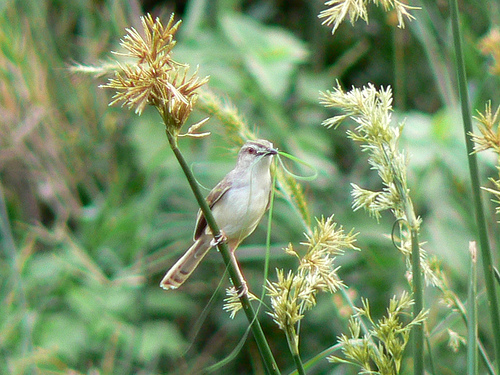- Tawny-flanked Prinia
Taxobox
name = Tawny-flanked Prinia
status = LC | status_system = IUCN3.1

image_width = 250px
image_caption = Collecting nest material inKruger National Park
regnum =Animal ia
phylum = Chordata
classis = Aves
ordo =Passeriformes
familia =Cisticolidae
genus = "Prinia "
species = "P. subflava"
binomial = "Prinia subflava"
binomial_authority = (Gmelin, 1789)The Tawny-flanked Prinia ("Prinia subflava") is a small
passerine bird belonging to thegenus "Prinia " in the familyCisticolidae , a family ofwarbler s. It is widespread and common in most parts ofAfrica south of theSahara . ThePlain Prinia ("P. inornata") of southernAsia was formerly included in this species but is now usually considered to be a separate species.Description
It is 10-13 centimetres in length with a long, narrow, graduated tail and a fairly long, slender bill. The tail is often held erect or waved from side to side. The upperparts are grey-brown with rufous-brown edges to the
flight feathers and a rufous tinge to the rump. The throat and breast are whitish while the flanks and vent are warm buff. There is a whitish stripe over the eye and the lores are dark. The tail feathers have a white tip and a dark subterminal band.The sexes are similar in appearance. Non-breeding birds have a longer tail than breeding birds. Juveniles have pale yellow underparts and a yellowish bill.
The call is short, wheezy and rapidly repeated. The song is a monotonous series of shrill notes. The male often sings from an exposed perch.
The
Pale Prinia ("P. somalica") of North-east Africa is similar but paler and greyer with whitish flanks. It inhabits drier, more open habitats than the Tawny-flanked Prinia. TheRiver Prinia ("P. fluviatilis") of West Africa is also paler and greyer and has a longer tail. It is restricted to waterside vegetation.Distribution and habitat
There are ten
subspecies distributed across most parts ofsub-Saharan Africa except for the driest and wettest areas. It is absent from theHorn of Africa , much of theCongo Basin , southernNamibia , south-westBotswana and the western half ofSouth Africa . It is found amongst shrubs and grass in a variety of habitats includingwoodland ,savanna and cultivated areas. It adapts well to man-made habitats and is not considered to be threatened.Behaviour
It feeds on
insect s and otherinvertebrate s. It forages in small flocks which move through shrubs and undergrowth.The nest is purse-shaped and made of strips of
grass woven together. It is built one to two metres above the ground. Two to four eggs are laid; they are variable in ground colour and usually have brown or purple spots or blotches.References
*Barlow, Clive; Wacher, Tim & Disley, Tony (1999) "A Field Guide to Birds of the Gambia and Senegal", Pica Press, Sussex.
*Serle, W.; Morel G.J. & Hartwig, W. (1977) "Collins Field Guide: Birds of West Africa", HarperCollins.
*Sinclair, Ian & Ryan, Peter (2003) "Birds of Africa south of the Sahara", Struik, Cape Town.
*Zimmerman, Dale A.; Turner, Donald A. & Pearson, David J. (1999) "Birds of Kenya & Northern Tanzania", Christopher Helm, London.External links
* [http://www.birdquest.net/afbid/search.php?func=searchresult&af_bs_id=1665 African Bird Image Database: Tawny-flanked Prinia]
Wikimedia Foundation. 2010.
